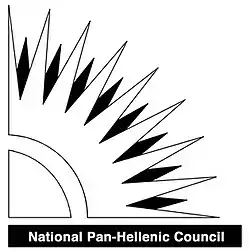National Pan-Hellenic Council
The National Pan-Hellenic Council (NPHC) is a collaborative umbrella organization composed of historically African American collegiate Greek-lettered fraternities and sororities. The nine NPHC organizations are sometimes collectively referred to as the "Divine Nine (D9)". The member/partner organizations have not formally adopted nor recommended the use of this term to describe their collaborative grouping. The NPHC was formed as a permanent organization on May 10, 1930 on the campus of Howard University, in Washington, D.C. with Matthew W. Bullock as the active Chairman and B. Beatrix Scott as Vice-Chairman. NPHC was incorporated under the laws of the State of Illinois in 1937 and is headquartered in Decatur, Georgia.
 | |
| Nickname | Divine Nine |
|---|---|
| Founded | May 10, 1930 |
| Founded at | Howard University |
| Type | Coalition of members |
| Headquarters | Decatur, Georgia |
| Website | https://nphchq.com/millennium1/ |
The council promotes interaction through forums, meetings, and other media for the exchange of information and engages in cooperative programming and initiatives through various activities and functions.
Each constituent member organization determines its own strategic direction and program agenda. Today, the primary purpose and focus of member organizations remains camaraderie and academic excellence for its members and service to the communities they serve. Each promotes community awareness and action through educational, economic, and cultural service activities.
History
The National Pan-Hellenic Council was established in an era when Greek letter organizations founded by African Americans were banned from being affiliated with Greek letter organizations founded by whites.[1]
The organization's stated purpose and mission in 1930:
Unanimity of thought and action as far as possible in the conduct of Greek letter collegiate fraternities and sororities, and to consider problems of mutual interest to its member organizations.[2]
The founding members of the NPHC were Kappa Alpha Psi, Omega Psi Phi, Alpha Kappa Alpha, Delta Sigma Theta, and Zeta Phi Beta. The council's membership expanded as Alpha Phi Alpha (1931), Phi Beta Sigma (1931), Sigma Gamma Rho (1937), and Iota Phi Theta (1996) joined this coalition of Black Greek letter organizations (BGLOs). In his book on BGLOs, The Divine Nine: The History of African-American Fraternities and Sororities in America (2001), Lawrence Ross coined the phrase "The Divine Nine" when referring to the coalition.[3]

As required by various campus recognition policies, neither the NPHC, nor its member national or chapter organizations discriminate on the basis of race or religion.
In 1992, the first permanent national office for NPHC was established in Bloomington, Indiana on the campus of Indiana University through the joint cooperation of Indiana University and the National Board of Directors of NPHC. Prior to its establishment, for over a 62-year period, the national office would sojourn from one officer to the next.[2]
Members
The members of the National Pan-Hellenic Council are shown below in order of founding:[2]
| Member | Greek Symbol | Founded | Incorporated | Colors | Headquarters | Chapters | Members | NPHC | Notes |
|---|---|---|---|---|---|---|---|---|---|
| Alpha Phi Alpha | ΑΦΑ | December 4, 1906 Cornell University |
April 3rd, 1912 | Black Old gold |
Baltimore, Maryland | 706[4] | 200,000[4] | 1931 | First intercollegiate African American fraternity. First of all NPHC organizations. |
| Alpha Kappa Alpha | ΑΚΑ | January 15, 1908 Howard University |
January 29, 1913 | Salmon Pink Apple Green |
Chicago, Illinois | 1,005[5] | 290,000[5] | 1930 | First intercollegiate African American sorority. First sorority of the NPHC. |
| Kappa Alpha Psi | ΚΑΨ | January 5, 1911 Indiana University as Kappa Alpha Nu |
May 15, 1911 | Crimson Cream |
Philadelphia, Pennsylvania | 720 | 160,000 | 1930 | First NPHC organization to be legally incorporated. |
| Omega Psi Phi | ΩΨΦ | November 17, 1911 Howard University |
October 28, 1914 | Royal purple Old gold |
Decatur, Georgia | 750 | 1930 | First NPHC fraternity to be founded at an HBCU. | |
| Delta Sigma Theta | ΔΣΘ | January 13, 1913 Howard University |
January 20, 1930 | Crimson Cream |
Washington, D.C. | over 940[6] (including alumnae chapters) |
1930 | Largest African American sorority to date. | |
| Phi Beta Sigma | ΦΒΣ | January 9, 1914 Howard University |
January 30, 1920 | Royal blue White |
Washington, D.C. | 740 | 185,000 | 1931 | Only NPHC fraternity constitutionally bound with a sorority (Zeta Phi Beta). |
| Zeta Phi Beta | ΖΦΒ | January 16, 1920 Howard University |
March 30, 1923 | Royal blue White |
Washington, D.C. | 800 | 1930 | Only NPHC sorority constitutionally bound with a fraternity (Phi Beta Sigma). | |
| Sigma Gamma Rho | ΣΓΡ | November 12, 1922 Butler University |
December 30, 1929 | Royal blue Gold |
Cary, North Carolina | 700 | 85,000+ | 1937 | Only NPHC sorority founded at a predominately White institution. |
| Iota Phi Theta | ΙΦΘ | September 19, 1963 Morgan State University |
November 1, 1968 | Charcoal brown Gilded gold |
Baltimore, Maryland | 300 | 30,000[7] | 1996 | Last NPHC organization to be founded. |
Traditional Greek housing
Traditional Greek housing amongst NPHC organizations is rare. Unlike most National Panhellenic Conference (NPC) and North American Interfraternity Conference (NIC) organizations that have many traditional Greek houses primarily for undergraduate members on or near their college campuses, NPHC organizations have a small few. Most of the few existing NPHC organization houses are untraditional and unaffiliated with a college. In recent years, a growing number of undergraduate chapters of NPHC organizations have advocated for convenient traditional Greek housing. In substitute of it, some undergraduate chapters have small outdoor Greek plots to help substantiate their presence on campus.[8][9][10][11][12][13][14][15][16]
See also
- Concilio Interfraternitario Puertorriqueño de la Florida
- Cultural interest fraternities and sororities
- Fraternity and Sorority Political Action Committee
- List of African-American fraternities
- List of social fraternities and sororities
- National Association of Latino Fraternal Organizations
- National Multicultural Greek Council
- Racism in Greek life
- United Council of Christian Fraternities and Sororities
References
- Gillon, Kathleen E.; Beatty, Cameron C.; Salinas, Cristobal (2019). "Race and Racism in Fraternity and Sorority Life: A Historical Overview". New Directions for Student Services. 2019 (165): 9–16. doi:10.1002/ss.20289.
- "About the National Pan-Hellenic Council". nphchq.org. Archived from the original on 2009-12-22. Retrieved 2008-01-16.
-
- Ross, Jr, Lawrence (2001). The Divine Nine: The History of African-American Fraternities and Sororities in America. New York: Kensington. pp. 37–38. ISBN 0-7582-0325-X.
- "Home". Alpha Phi Alpha. Retrieved 2016-09-07.
- "Alpha Kappa Alpha Sorority, Inc". aka1908.com. Retrieved 2016-09-07.
- Delta Sigma Theta website Archived 2016-04-12 at the Wayback Machine. Retrieved April 4, 2016.
- "Iota Phi Theta® Fraternity Inc. | Founded 1963 - Chapter Locator". www.iotaphitheta.org. Retrieved 2016-09-07.
- https://thedmonline.com/black-fraternity-houses/
- https://www.dailytarheel.com/article/2018/08/black-greek-life-0822
- https://thedepauw.com/mgc-and-nphc-houses-still-not-on-campus-maps/
- https://www.memphisflyer.com/NewsBlog/archives/2019/08/16/u-of-m-students-look-to-raise-funds-for-african-american-greek-organizations
- http://www.charlottedst.org/aboutus/membership.html
- https://www.studentprintz.com/white-vs-black-greek-life-theres-a-greek-letter-for-everyone/
- https://www.idsnews.com/article/2019/01/greek-life-has-lost-its-identity-at-iu
- https://themsuspokesman.com/8240/campus-news/greek-plots-return-to-morgans-campus/
- https://www.34st.com/article/2017/03/black-greek-life-at-penn
Further reading
- Brown, Tamara L., Gregory S. Parks, and Clarenda M. Phillips. (2005). African American Fraternities and Sororities: The Legacy and the Vision. Lexington, KY: University Press of Kentucky. ISBN 978-0-8131-2344-8.
- Parks, Gregory Scott. (2008). Black Greek-Letter Organizations in the 21st Century: Our Fight Has Just Begun. Lexington, KY: University Press of Kentucky. ISBN 978-0-8131-2491-9.
- Skocpol, Theda, Ariane Liazos, and Marshall Ganz. (2006). What a Mighty Power We Can Be: African American Fraternal Groups and the Struggle for Racial Equality . Princeton, NJ: Princeton University Press. ISBN 978-0-691-12299-1.